Dual Benefits in Yield Enhancement and Grain Desiccation: Irrigation Coupled with Husk Removal Modulates Grain Moisture Dynamics in Maize
Abstract
1. Introduction
2. Materials and Methods
2.1. Experimental Conditions and Treatments
2.2. Plant Sampling and Trait Analysis
2.3. Statistics
3. Results
3.1. Grain-Filling Characteristics
3.2. Grain Yield and Its Components
3.3. Relationship Between Grain Water Content, Grain Dry Weight, and Yield
4. Discussion
5. Conclusions
Supplementary Materials
Author Contributions
Funding
Data Availability Statement
Conflicts of Interest
Abbreviations
| WI | well irrigation |
| NI | no irrigation |
| H0 | no husk removal |
| H1/4 | 1/4 of husk layer removal |
| H2/4 | 2/4 of husk layer removal |
| H3/4 | 3/4 of husk layer removal |
| H4/4 | 4/4 of husk layer removal |
| GY | grain yield |
| GW | thousand-grain weight |
| GN | grain number |
| Tm | the thermal time at maximum grain-filling rate |
| Wm | hundred-grain weight at maximum grain-filling rate |
| Gm | maximum grain-filling rate |
| GFD | grain-filling duration |
| GWC | grain water content |
| MWC | maximum water content |
| TTM | thermal time at MWC |
| DMM | dry matter weight at MWC |
| GBM | grain growth rate before maximum water content |
| GAM | grain growth rate after maximum water content |
References
- Erenstein, O.; Jaleta, M.; Sonder, K.; Mottaleb, K.; Prasanna, B.M. Global maize production, consumption and trade: Trends and R&D implications. Food Secur. 2022, 14, 1295–1319. [Google Scholar] [CrossRef]
- Liu, Z.; Hao, Z.; Sha, Y.; Huang, Y.; Guo, W.; Ke, L.; Chen, F.; Yuan, L.; Mi, G. High responsiveness of maize grain yield to nitrogen supply is explained by high ear growth rate and efficient ear nitrogen allocation. Field Crops Res. 2022, 286, 108610. [Google Scholar] [CrossRef]
- Lobell, D.B.; Roberts, M.J.; Schlenker, W.; Braun, N.; Little, B.B.; Rejesus, R.M.; Hammer, G.L. Greater sensitivity to drought accompanies maize yield increase in the U.S. Midwest. Science 2014, 344, 516–519. [Google Scholar] [CrossRef] [PubMed]
- Lu, H.D.; Xue, J.Q.; Guo, D.W. Efficacy of planting date adjustment as a cultivation strategy to cope with drought stress and increase rainfed maize yield and water–use efficiency. Agric. Water Manag. 2017, 179, 18–33. [Google Scholar] [CrossRef]
- Wu, T.A.; Liu, K.; Cheng, M.; Gu, Z.; Guo, W.; Jiao, X. Paddy field scale evapotranspiration estimation based on two-source energy balance model with energy flux constraints and UAV multimodal data. Remote Sens. 2025, 17, 1662. [Google Scholar] [CrossRef]
- Mueller, S.M.; Messina, C.D.; Vyn, T.J. The role of the exponential and linear phases of maize (Zea mays L.) ear growth for determination of kernel number and kernel weight. Eur. J. Agron. 2019, 111, 125939. [Google Scholar] [CrossRef]
- Yi, J.; Li, H.; Zhao, Y.; Shao, M.A.; Zhang, H.; Liu, M. Assessing soil water balance to optimize irrigation schedules of flood-irrigated maize fields with different cultivation histories in the arid region. Agric. Water Manag. 2022, 265, 107543. [Google Scholar] [CrossRef]
- Melchiori, R.J.M.; Caviglia, O.P. Maize kernel growth and kernel water relations as affected by nitrogen supply. Field Crops Res. 2008, 108, 198–205. [Google Scholar] [CrossRef]
- Sheoran, S.; Kaur, Y.; Kumar, S.; Shukla, S.; Rakshit, S.; Kumar, R. Recent advances for drought stress tolerance in maize (Zea mays L.): Present status and future prospects. Front. Plant Sci. 2022, 13, 872566. [Google Scholar] [CrossRef]
- Fu, J.; Huang, Z.H.; Wang, Z.Q.; Yang, J.C.; Zhang, J.H. Pre–anthesis non–structural carbohydrate reserve in the stem enhances the sink strength of inferior spikelets during grain filling of rice. Field Crop. Res. 2011, 123, 170–182. [Google Scholar] [CrossRef]
- Wang, D.; Yu, Z.W.; White, P.J. The effect of supplemental irrigation after jointing on leaf senescence and grain filling in wheat. Field Crops Res. 2013, 151, 35–44. [Google Scholar] [CrossRef]
- Li, Y.B.; Tao, H.B.; Zhang, B.C.; Huang, S.B.; Wang, P. Timing of water deficit limits maize kernel setting in association with changes in the source–flow–sink relationship. Front. Plant Sci. 2018, 9, 1326. [Google Scholar] [CrossRef] [PubMed]
- Hammad, H.M.; Abbas, F.; Ahmad, A.; Bakhat, H.F.; Farhad, W.; Wilkerson, C.J.; Fahad, S.; Hoogenboom, G. Predicting kernel growth of maize under controlled water and nitrogen applications. Int. J. Plant Prod. 2020, 14, 609–620. [Google Scholar] [CrossRef]
- Zhai, L.; Wang, Z.; Song, S.; Zhang, L.; Zhang, Z.; Jia, X. Tillage practices affects the grain filling of inferior kernel of summer maize by regulating soil water content and photosynthetic capacity. Agric. Water Manag. 2021, 245, 106600. [Google Scholar] [CrossRef]
- Borrás, L.; Zinselmeier, C.; Lynn Senior, M.; Westgate, M.E.; Muszynski, M.G. Characterization of grain–filling patterns in diverse maize germplasm. Crop Sci. 2009, 49, 999–1009. [Google Scholar] [CrossRef]
- Muhammad, I.N.; Astutik, S.; Indarto, I.; Mujib, M.A.; Pangastuti, E.I.; Kurnianto, A. Evaluation of groundwater salinity and suitability for irrigation purposes on South Coastal Jember Regency. Water Conserv. Manag. 2024, 8, 267–273. [Google Scholar] [CrossRef]
- Zhao, J.; Xue, Q.W.; Jessup, K.E.; Hao, B.Z.; Hou, X.B.; Marek, T.H.; Xu, W.W.; Evett, S.R.; O’Shaughnessy, S.A.; Brauer, D.K. Yield and water use of drought–tolerant maize hybrids in a semiarid environment. Field Crops Res. 2018, 216, 1–9. [Google Scholar] [CrossRef]
- Westgate, M.E. Water status and development of the maize endosperm and embryo during drought. Crop Sci. 1994, 34, 76–83. [Google Scholar] [CrossRef]
- Saini, H.S.; Westgate, M.E. Reproductive development in grain crops during drought. Adv. Agron. 1999, 68, 59–96. [Google Scholar] [CrossRef]
- Borrás, L.; Westgate, M.E. Predicting maize kernel sink capacity early in development. Field Crops Res. 2006, 95, 223–233. [Google Scholar] [CrossRef]
- Yan, P.; Chen, Y.Q.; Sui, P.; Vogel, A.; Zhang, X.P. Effect of maize plant morphology on the formation of apical kernels at different sowing dates and under different plant densities. Field Crops Res. 2018, 223, 83–92. [Google Scholar] [CrossRef]
- Yan, S.C.; Wu, Y.; Fan, J.L.; Zhang, F.C.; Qiang, S.C.; Zheng, J.; Xiang, Y.Z.; Guo, J.J.; Zou, H.Y. Effects of water and fertilizer management on grain filling characteristics, grain weight and productivity of drip–fertigated winter wheat. Agric. Water Manag. 2019, 213, 983–995. [Google Scholar] [CrossRef]
- Salvador, D.W.; Pearce, R.B. Husk removal and its effects on maize grain yield. Crop Sci. 1988, 28, 961–964. [Google Scholar] [CrossRef]
- Fujita, K.; Sato, H.; Sawada, O.; Sendo, S. Husk leaves contribution to dry matter and grain production as well as n distribution in flint corn (Zea mays L.) genotypes differing in husk leaf area. Soil Sci. Plant Nutr. 1995, 41, 587–596. [Google Scholar] [CrossRef]
- Zhou, G.F.; Hao, D.R.; Chen, G.Q.; Lu, H.H.; Shi, M.L.; Mao, Y.X.; Zhang, Z.L.; Huang, X.L.; Xue, L. Genome–wide association study of the husk number and weight in maize (Zea mays L.). Euphytica 2016, 210, 195–205. [Google Scholar] [CrossRef]
- Wang, T.; Li, F.M.; Turner, N.C.; Wang, B.R.; Wu, F.; Anten, N.P.R.; Du, Y.L. Accelerated grain–filling rate increases seed size and grain yield of recent naked oat cultivars under well–watered and water–deficit conditions. Eur. J. Agron. 2020, 116, 126047. [Google Scholar] [CrossRef]
- Gasura, E.; Setimela, P.; Edema, R.; Gibson, P.T.; Okori, P.; Tarekegne, A. Exploiting grain–filling rate and effective grain–filling duration to improve grain yield of early–maturing maize. Crop Sci. 2013, 53, 2295–2303. [Google Scholar] [CrossRef]
- Archontoulis, S.V.; Miguez, F.E. Nonlinear regression models and applications in agricultural research. Agron. J. 2015, 107, 786–798. [Google Scholar] [CrossRef]
- Lemcoff, J.H.; Loomis, R.S. Nitrogen and density influences on silk emergence, endosperm development, and grain yield in maize (Zea mays L.). Field Crops Res. 1994, 38, 63–72. [Google Scholar] [CrossRef]
- Gambín, B.L.; Borrás, L.; Otegui, M.E. Source–sink relations and kernel weight differences in maize temperate hybrids. Field Crops Res. 2006, 95, 316–326. [Google Scholar] [CrossRef]
- Severini, A.D.; Borrás, L.; Westgatec, M.E.; Cirilo, A.G. Kernel number and kernel weight determination in dent and popcorn maize. Field Crops Res. 2011, 120, 360–369. [Google Scholar] [CrossRef]
- Oury, V.; Tardieu, F.; Turc, O. Ovary apical abortion under water deficit is caused by changes in sequential development of ovaries and in silk growth rate in maize. Plant Physiol. 2016, 171, 986–996. [Google Scholar] [CrossRef] [PubMed]
- Shen, S.; Zhang, L.; Liang, X.G.; Zhao, X.; Lin, S.; Qu, L.H.; Liu, Y.P.; Gao, Z.; Ruan, Y.L.; Zhou, S.L. Delayed pollination and low availability of assimilates are major factors causing maize kernel abortion. J. Exp. Bot. 2018, 69, 1599–1613. [Google Scholar] [CrossRef] [PubMed]
- Hanft, J.M.; Jones, R.J. Kernel abortion in maize. I. Carbohydrate concentration patterns and acid invertase activity of maize kernels induced to abort in vitro. Plant Physiol. 1986, 81, 503–510. [Google Scholar] [CrossRef]
- Boyer, J.; Westgate, M. Grain yields with limited water. J. Exp. Bot. 2004, 55, 2385–2394. [Google Scholar] [CrossRef]
- Mclaughlin, J.E.; Boyer, J.S. Glucose localization in maize ovaries when kernel number decreases at low water potential and sucrose is fed to the stems. Ann. Bot. 2004, 94, 75–86. [Google Scholar] [CrossRef]
- Feng, H.Y.; Wang, Z.M.; Kong, F.N.; Zhang, M.J.; Zhou, S.L. Roles of carbohydrate supply and ethylene, polyamines in maize kernel set. J. Integr. Plant Biol. 2011, 53, 388–398. [Google Scholar] [CrossRef]
- Gao, Z.; Liang, X.G.; Lin, S.; Zhao, X.; Zhang, L.; Zhou, L.L.; Shen, S.; Zhou, S.L. Supplemental irrigation at tasseling optimizes water and nitrogen distribution for high–yield production in spring maize. Field Crops Res. 2017, 209, 120–128. [Google Scholar] [CrossRef]

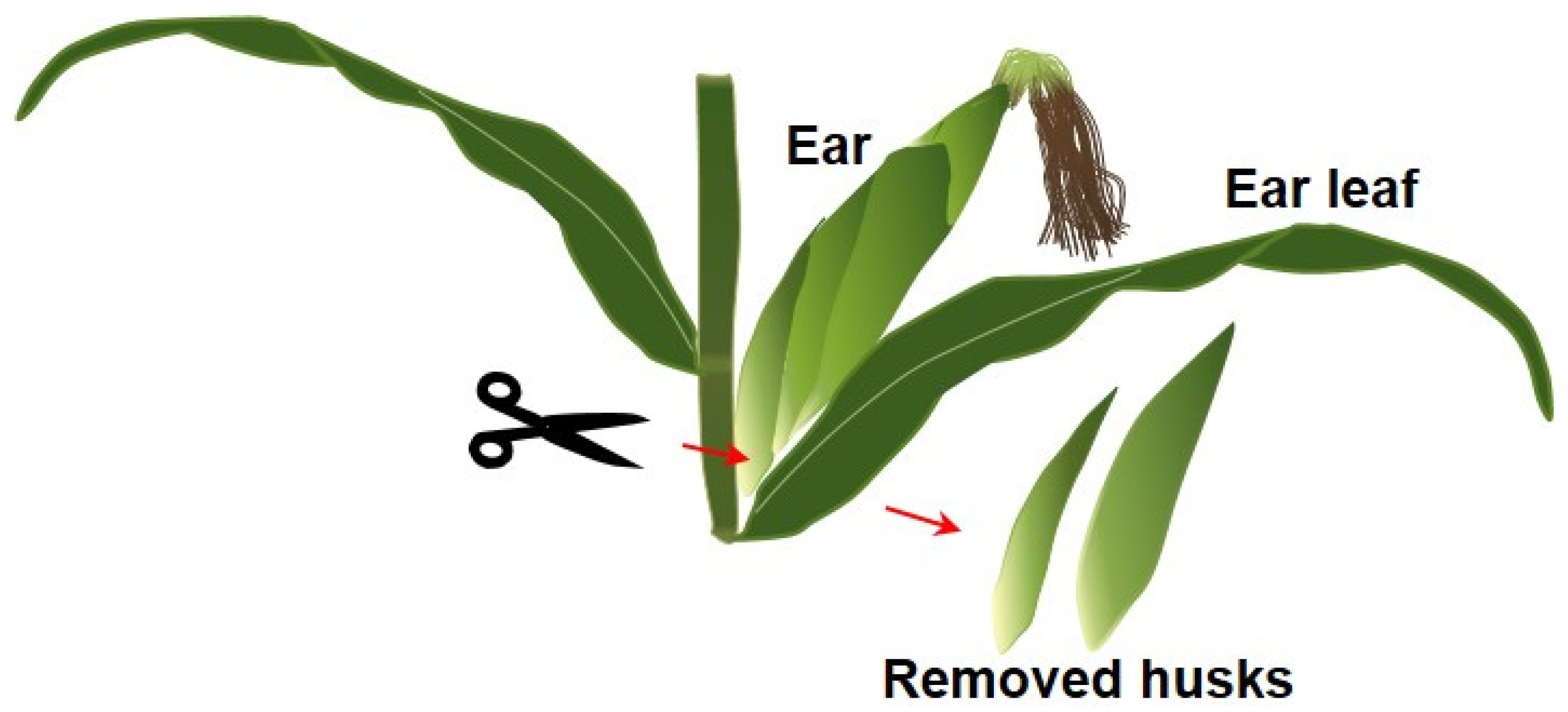
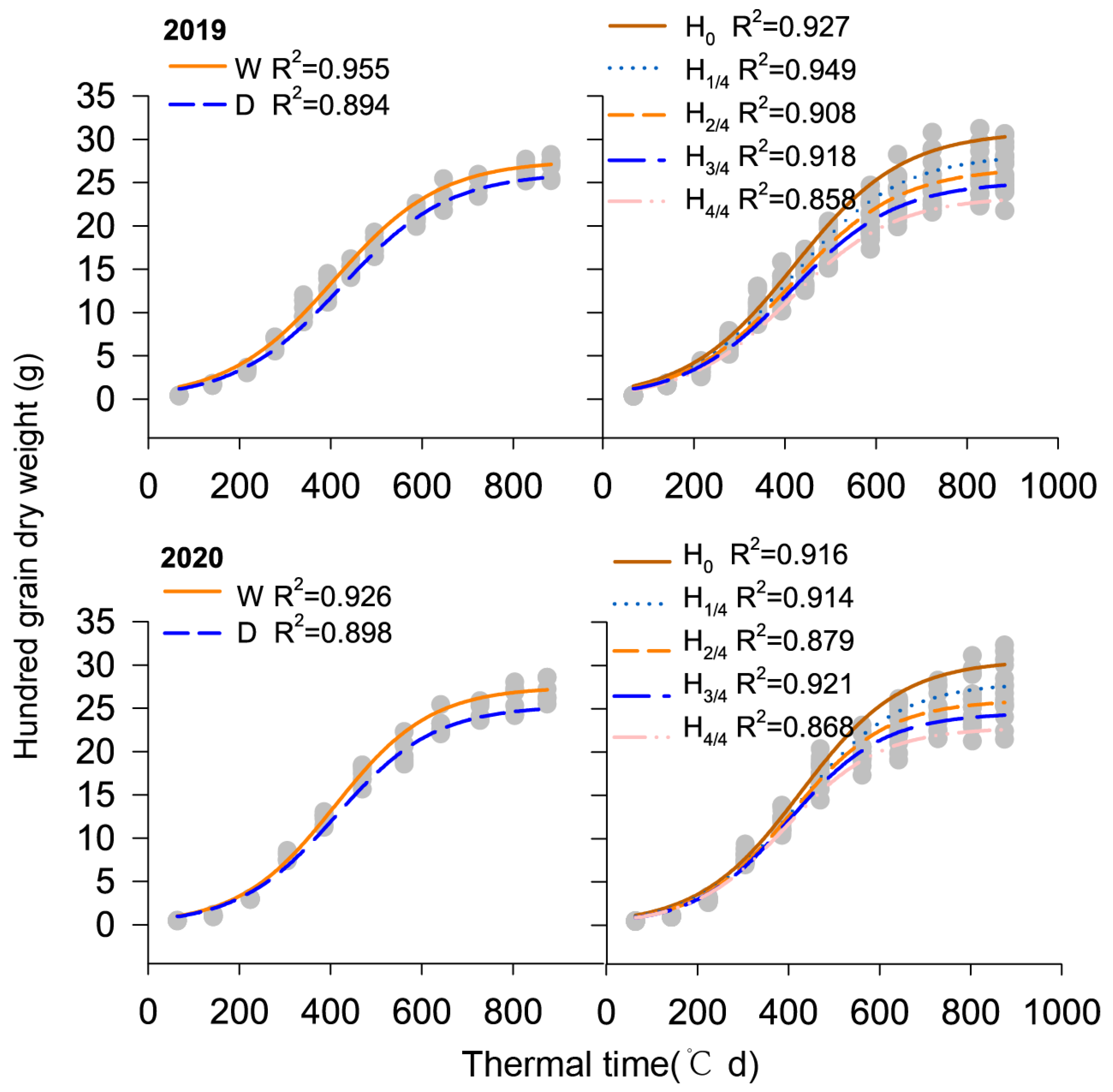
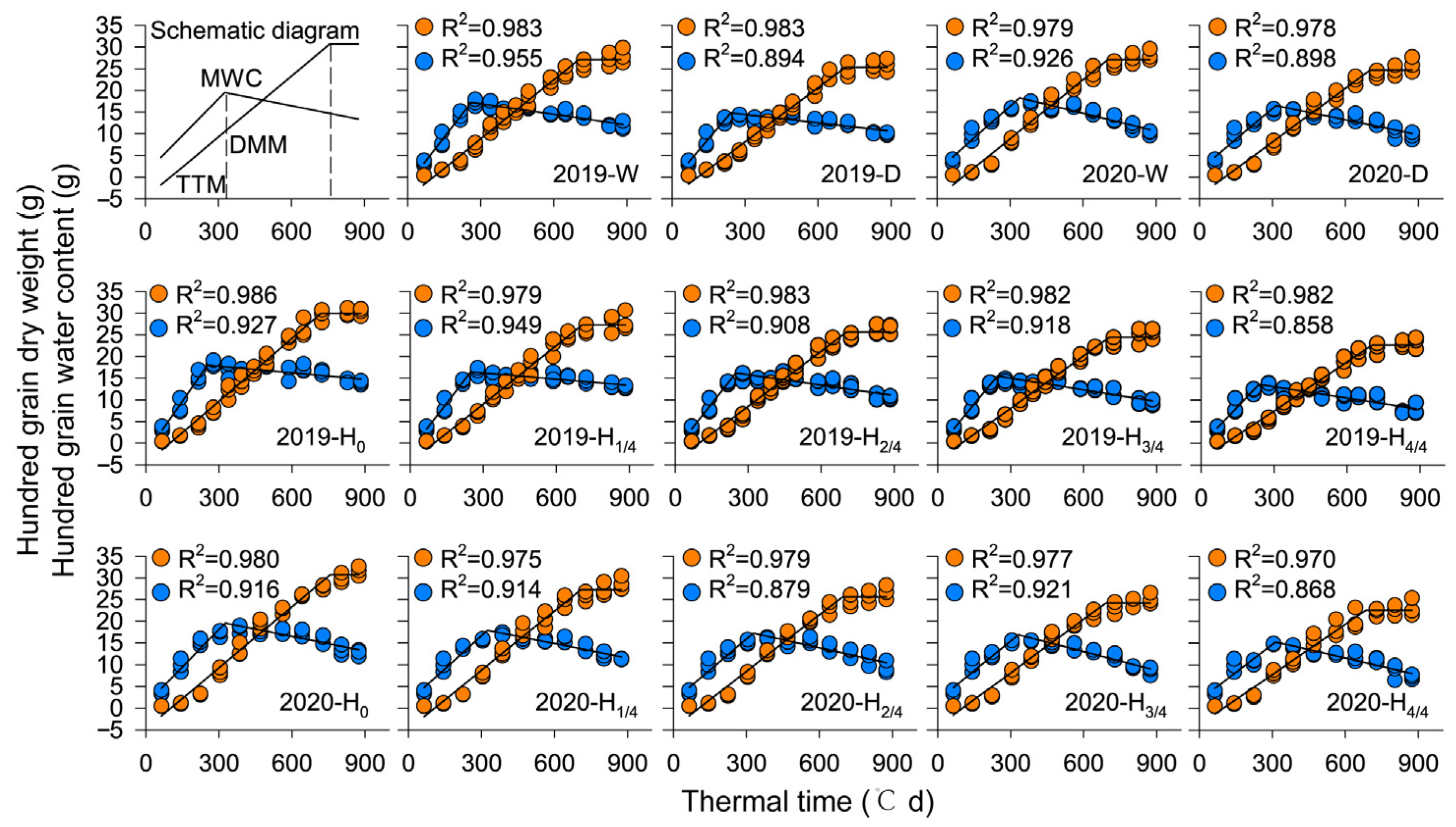
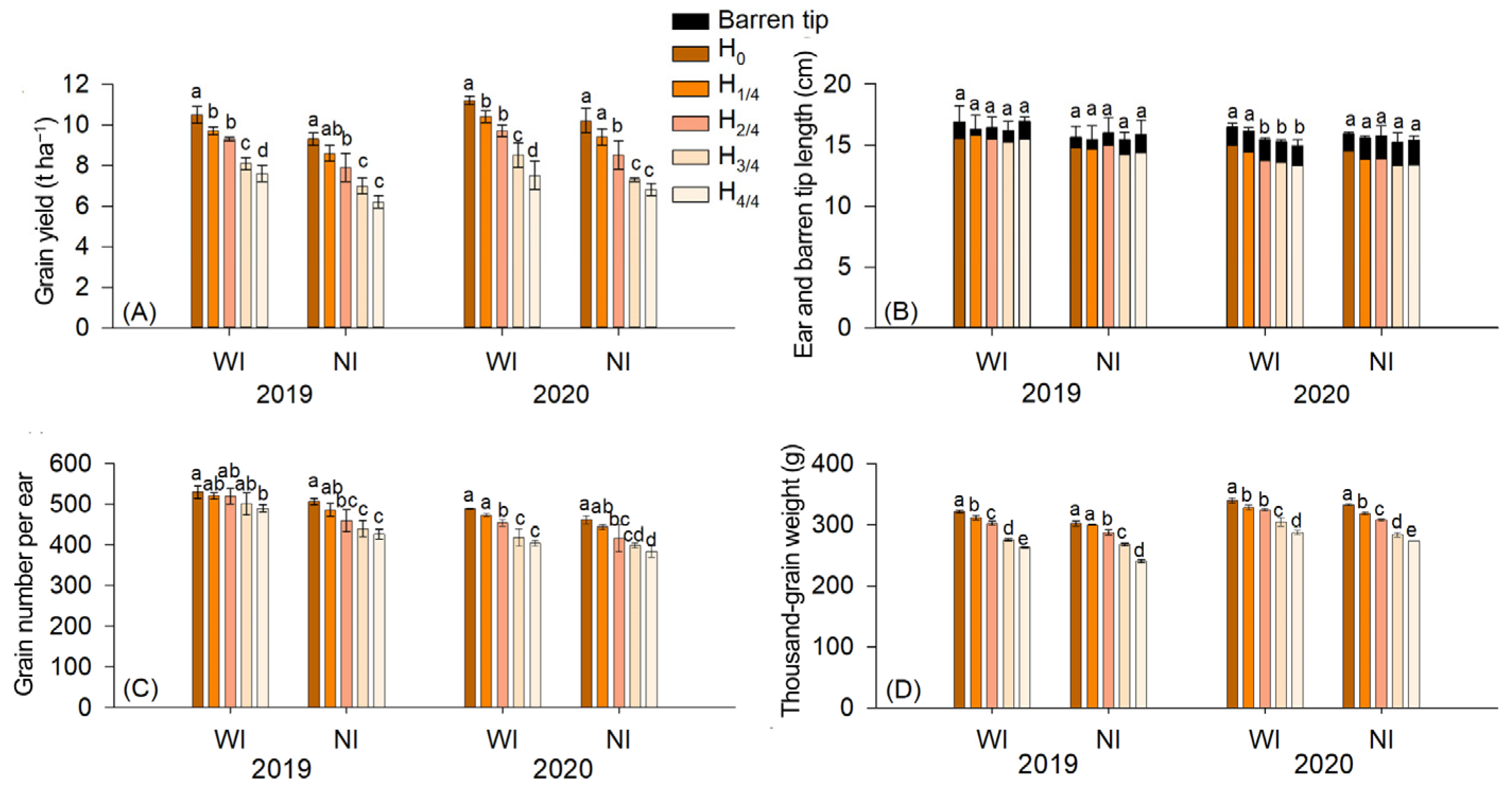
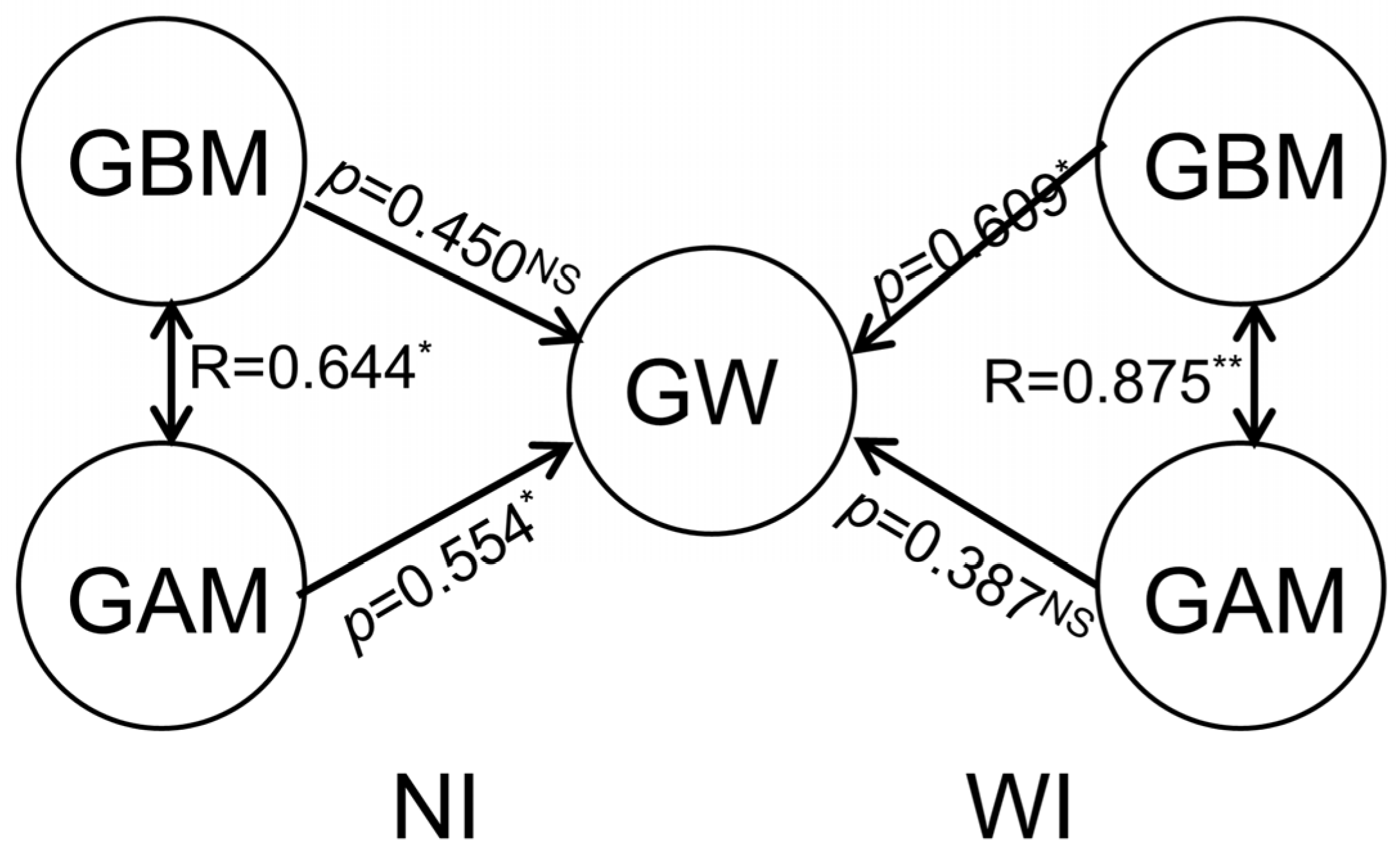


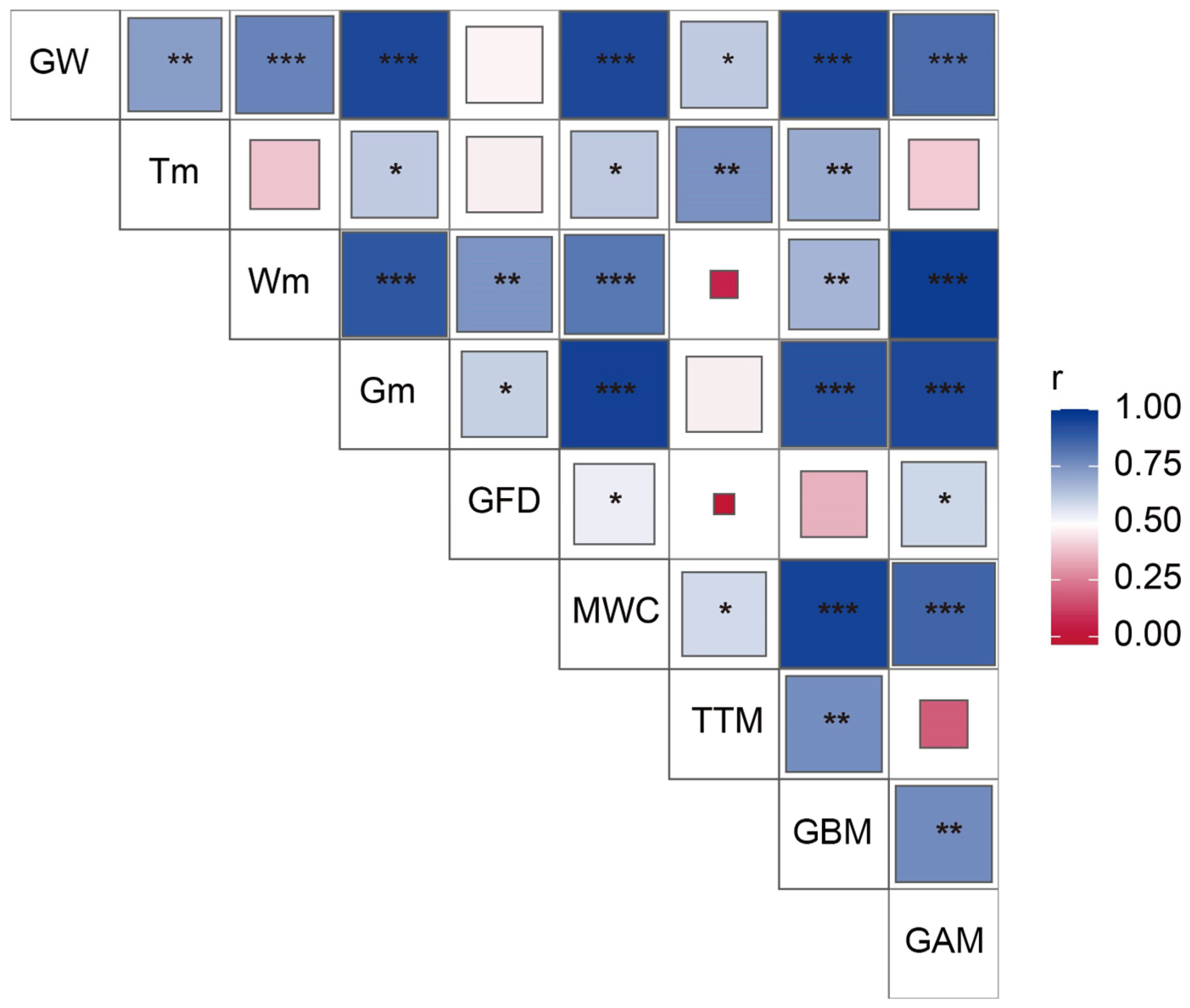
| Indicator (Sample Size) | Year (Y) | Irrigation (I) | Husk (H) | Y × I | Y × H | I × H | Y × I × H |
|---|---|---|---|---|---|---|---|
| Grain water content (720) | ** 1 | ** | ** | NS | ** | ** | NS |
| Grain dry weight (720) | NS | * | ** | NS | NS | NS | NS |
| Ear length (60) | * | * | NS | * | NS | NS | NS |
| Grain number (60) | ** | ** | ** | * | NS | NS | NS |
| Thousand-grain weight (60) | ** | ** | ** | NS | * | NS | ** |
| Grain yield (60) | ** | ** | ** | NS | NS | NS | NS |
Disclaimer/Publisher’s Note: The statements, opinions and data contained in all publications are solely those of the individual author(s) and contributor(s) and not of MDPI and/or the editor(s). MDPI and/or the editor(s) disclaim responsibility for any injury to people or property resulting from any ideas, methods, instructions or products referred to in the content. |
© 2025 by the authors. Licensee MDPI, Basel, Switzerland. This article is an open access article distributed under the terms and conditions of the Creative Commons Attribution (CC BY) license (https://creativecommons.org/licenses/by/4.0/).
Share and Cite
Gao, J.; Fa, K.; Huang, S.; Wang, P.; Liu, Z. Dual Benefits in Yield Enhancement and Grain Desiccation: Irrigation Coupled with Husk Removal Modulates Grain Moisture Dynamics in Maize. Water 2025, 17, 1974. https://doi.org/10.3390/w17131974
Gao J, Fa K, Huang S, Wang P, Liu Z. Dual Benefits in Yield Enhancement and Grain Desiccation: Irrigation Coupled with Husk Removal Modulates Grain Moisture Dynamics in Maize. Water. 2025; 17(13):1974. https://doi.org/10.3390/w17131974
Chicago/Turabian StyleGao, Jia, Keyu Fa, Shoubing Huang, Pu Wang, and Zheng Liu. 2025. "Dual Benefits in Yield Enhancement and Grain Desiccation: Irrigation Coupled with Husk Removal Modulates Grain Moisture Dynamics in Maize" Water 17, no. 13: 1974. https://doi.org/10.3390/w17131974
APA StyleGao, J., Fa, K., Huang, S., Wang, P., & Liu, Z. (2025). Dual Benefits in Yield Enhancement and Grain Desiccation: Irrigation Coupled with Husk Removal Modulates Grain Moisture Dynamics in Maize. Water, 17(13), 1974. https://doi.org/10.3390/w17131974








